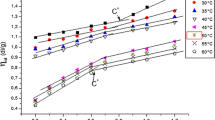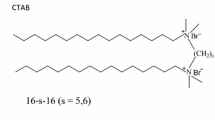Abstract
The micellization behaviour of sodium dodecyl sulphate, sodium dodecylbenzenesulfonate, hexadecyltrimethylammonium bromide, tetradecyltrimethylammonium bromide, and cetylpyridinium chloride in water and in aqueous solutions of polyethylene oxide (PEO, molecular weight = 100,000) having concentrations (0.005–0.04 %, w/v) has been studied at different temperatures (288.15–318.15 K) using conductivity, surface tension, and viscosity methods. From conductivity measurements various micellar parameters, like critical micellar concentration (CMC), critical aggregation concentration (CAC), polymer saturation point (PSP), degree of ionization (β), and standard free energy of transfer (\( \Delta G_{t}^{0} \)), have been calculated. CAC values have been found to decrease with polymer concentration and increase with temperature. However, the PSP values increase with both polymer concentration and temperature for all surfactants. Similar parameters have also been calculated from surface tension data (CMCσ, CACσ, PSPσ) along with other parameters such as maximum surface excess concentration at the air/water interface (\( \Gamma_{\hbox{max} } \)), minimum area per molecule (A min), and packing parameter (p). The CMCσ, CACσ, and PSPσ values are smaller than the corresponding CMC, CAC, and PSP values, but both show similar behaviour with temperature and concentration of polymer. Various parameters indicate that the presence of the aromatic ring in the head group of surfactant decreases its interaction with PEO, whereas the increased hydrophobicity in the tail leads to stronger interactions with PEO. Viscosity studies further supplement the conclusions drawn from the above results.








Similar content being viewed by others
References
Mukhim T, Ismail K (2012) Aggregation, counter ion binding and adsorption behaviours of cetylpyridinium chloride in water/glycerol media at 25 °C. J Surfact Deterg 15:47–51
Smith GN, Brown P, Rogers SE, Eastoe J (2013) Evidence for a critical micelle concentration of surfactants in hydrocarbon solvent. Langmuir 29:3252–3258
Qi S, Roser S, Edler KJ, Pigliacelli C, Rogerson M, Weuts I, Dycke FV, Stokbroekx S (2013) Insights into the role of polymer—surfactant complexes in drug solubilisation/stabilisation during drug release from solid dispersions. Pharm Res 30:290–302
Yang F, Hai M (2013) Thermodynamics properties of poly (ethanol) with and without sodium dodecyl sulphate by viscosity, surface tension, and dynamic light scattering. J Chem Eng Data 58:2051–2057
Ortona O, Errico GD, Paduano L, Sartorio R (2002) Ionic surfactant—polymer interaction in aqueous solution. Phys Chem Chem Phys 4:2604–2611
Wang C, Tam KC (2002) New insights on the interaction mechanism within oppositely charged polymer/surfactant systems. Langmuir 18:6484–6490
Ansari AA, Kamil M, Kabir-ud-Din (2013) Polymer—Surfactant interactions and the effect of tail size variation on micellization process of cationic ATAB surfactants in aqueous medium. J Dispers Sci Technol 34:722–730
Bayrak Y, Tüfeçki S (2013) Thermodynamic studies of interaction between CTAB and carboxymethylcellulose using different techniques. J Dispers Sci Technol 34:1079–1084
Zanette D, Ruzza AA, Froehner SJ, Minatti E (1996) Polymer-surfactant interactions demonstrated by a kinetic probe: degree of ionization. Colloids Surf A 108:91–100
Hou Z, Li Z, Wang H (1999) Interaction between poly(ethylene oxide) and sodium dodecyl sulfonate as studied by surface tension, conductivity, viscosity, electron spin resonance and nuclear magnetic resonance. Colloid Polym Sci 277:1011–1018
Niranjan PS, Upadhyay SK (2010) Interaction of polyacrylamide with conventional anionic and Gemini anionic surfactants. J Dispers Sci Technol 32:109–113
Bakshi MS, Kaur R, Kaur I, Mahajan RK, Sehgal P, Doe H (2003) Unlike surfactant—polymer interactions of sodium dodecyl sulphate and sodiumdodecylbenzene sulfonate with water—soluble polymers. Colloid Polym Sci 281:716–726
Niranjan PS, Shukla R, Upadhyay SK (2012) Interactions of polyacrylamide with cationic surfactants: thermodynamic and surface parameters. J Surfact Deterg 15:53–57
Öztekin N, Erim FB (2013) Determination of critical aggregation concentration in poly—(vinylpyrrolidone)—sodium dodecyl sulphate system by capillary electrophoresis. J Surfact Deterg 16:363–367
Manna K, Panda AK (2011) Physiochemical studies on the interfacial and micellization behaviour of CTAB in aqueous polyethylene glycol media. J Surfact Deterg 14:563–576
Modaressi A, Sifaoui H, Grzesiak B, Solimando R, Domanska U, Rogalski M (2006) CTAB aggregation in aqueous solutions of ammonium based ionic liquids; conductometric studies. Colloids Surf A 296:104–108
Bashford MT, Wooley EM (1985) Enthalpies of dilution of aqueous decyl-, dodecyl-, tetradecyl-, and hexadecyl trimethyl ammonium bromides at 10, 25, 40 and 55 °C. J Phys Chem 89:3173–3179
Chatterjee A, Moulik SP, Sanyal SK, Mishra BK, Puri PM (2001) Thermodynamics of micelleformation of ionic surfactants: a critical assessment for sodium dodecyl sulfate, cetyl pyridinium chloride and dioctyl sulfosuccinate (Na salt) by microcalorimetric, conductometric and tensiometric measurements. J Phys Chem B 105:12823–12831
Dubey N (2012) Study of micellization of aqueous sodium dodecylbenzene sulfonate in alcohol solutions. J Surface Sci Techol 28:55–70
Das D, Ismail K (2008) Aggregation and adsorption properties of sodium dodecyl sulphate in water—acetamide mixtures. J Colloid Interface Sci 327:198–203
Varade D, Joshi T, Aswal VK, Goyal PS, Hassan PA, Bahadur P (2005) Effect of salt on the micelles of cetyl pyridinium chloride. Colloid Surf A 259:95–101
Evans DF, Wightman PJ (1982) Micelle formation above 100 °C. J Colloid Interface Sci 86:515–524
Wang G, Olofsson G (1998) Titration calorimetric study of the interaction between ionic surfactants and uncharged polymers in aqueous solution. J Phys Chem B 102:9276–9283
Loh W, Teixeira LAC, Lee LT (2004) Isothermal calorimetric investigation of the interaction of poly(N-isopropylacrylamide) and ionic surfactants. J Phys Chem B108:3196–3201
Zana R (1980) Ionization of cationic micelles: effect of the detergent structure. J Colloid Interface Sci 78:330–337
Vikingstad E, Saetersdal H (1979) Partial molar volumes and compressibilities of the homologous series of long chained sodium-alkyl malonates in aqueous solution at 25 °C. J Colloid Interface Sci 77:407–412
Azum N, Rub MA, Asiri AM, Parwaz Khan AA, Khan A (2013) Physico-chemical investigations of mixed micelles of cationic Gemini and conventional surfactants: a conductometric study. J Surfact Deterg 16:77–84
Villetti MA, Bica CID, Garcia ITS, Pereira FV, Ziembowicz FI, Kloster CL, Giacomelli C (2011) Physiochemical properties of methylcellulose and dodecyltrimethylammonium bromide in aqueous medium. J Phys Chem B 115:5868–5876
Panda AK, Sarkar G, Manna K (2009) Physicochemical studies on surfactant aggregation 1. Effect of polyethylene glycols on the micellization of SDS. J Dispers Sci Technol 30:1152–1160
Majhi PR, Moulik SP, Burke SE, Rodgers M, Palepu R (2001) Physiochemical investigations on the interaction of surfactants and salts with polyvinylpyrrolidone in aqueous medium. J Colloid Interface Sci 235:227–234
Brackmans JC, Engberts JBFN (1993) Polymer—micelle interactions. Chem Soc Rev Phys Org Aspects 22:85–92
Minatti E, Zanette D (1996) Salt effects on the interaction of poly (ethylene oxide) and sodium dodecyl sulphate measured by conductivity. Colloids Surf A 113:237–246
Kamenka N, Burgaud I, Treiner C, Zana R (1994) Interaction of copper (II) dodecyl sulfate with poly (ethylene oxide) and poly (vinylpyrrolidone): self-diffusion, fluorescence probing, and conductivity study. Langmuir 10:3455–3460
Chakraborty T, Ghosh S, Moulik SP (2005) Micellization and related behaviour of binary and ternary surfactant mixtures in aqueous medium: cetyl pyridinium chloride (CPC), cetyl trimethyl ammonium bromide (CTAB), and polyoxyethylene (10) cetyl ether (Brij-56) derived system. J Phys Chem B 109:14813–14823
Umlong IM, Ismail K (2007) Micellization behaviour of sodium dodecyl sulphate in different electrolyte media. Colloids Surf A 299:8–14
Hait SK, Majhi PR, Blume A, Moulik SP (2003) A critical assessment of micellization of sodium dodecyl benzene sulfonate (SDBS) and its interaction with poly(vinyl pyrrolidone) and hydrophobically modified polymers, JR 400 and LM 200. J Phys Chem B 107:3650–3658
Kabir-ud-Din, Khan AB, Naqvi AZ (2012) Mixed micellization and interfacial properties of non-ionic surfactants with the phenothiazine drug promazine hydrochloride at 30 °C. J Solut Chem 41:1587–1599
Eastoe J, Nave S, Downer A, Paul A, Rankin A, Tribe K, Penfold J (2000) Adsorption of ionic surfactants at the air-solution interface. Langmuir 16:4511–4518
Israelachvili JN, Mitchell DJ, Ninham BW (1976) Theory of self-assembly of hydrocarbon amphiphiles into micelles and bilayers. J Chem Soc Faraday Trans 2:1525–1569
Tanford C (1980) The hydrophobic effect: formation of micelles and biological membranes. Wiley, NewYork
Abdel-Salam FH, El-Said AG (2011) Synthesis and surface active properties of Gemini cationic surfactants and interaction with anionic azo dye (AR52). J Surfact Deterg 14:371–379
Rosen MJ (2004) Surfactants and interfacial phenomena. Wiley, New York
Zana R, Candau S (1981) Effect of alcohols on the properties of micellar systems: III. Elastic and quasielastic light scattering study. J Colloid Interface Sci 84:206–219
Sohrabi B, Gharibi H, Tajik B, Javadian S, Hashemianzadeh M (2008) Molecular interactions of cationic and anionic surfactants in mixed monolayers and aggregates. J Phys Chem B 112:14869–14876
Mahajan S, Sharma R, Mahajan RK (2012) An investigation of drug binding ability of a surface active ionic liquid: micellization, electrochemical, and spectroscopic studies. Langmuir 28:17238–17246
Liu H, Hai M (2010) Investigation on the interaction between sodium dodecyl sulphate and non-ionic polymer with electrolytes by viscosity and surface tension. J Chem Eng Data 55:354–357
Acknowledgments
Harjinder Kaur thanks the University Grants Commission (UGC), India for the award of JRF (Junior Research Fellowship).
Author information
Authors and Affiliations
Corresponding author
Electronic supplementary material
Below is the link to the electronic supplementary material.
About this article
Cite this article
Banipal, T.S., Kaur, H., Banipal, P.K. et al. Effect of Head Groups, Temperature, and Polymer Concentration on Surfactant—Polymer Interactions. J Surfact Deterg 17, 1181–1191 (2014). https://doi.org/10.1007/s11743-014-1633-y
Received:
Accepted:
Published:
Issue Date:
DOI: https://doi.org/10.1007/s11743-014-1633-y




